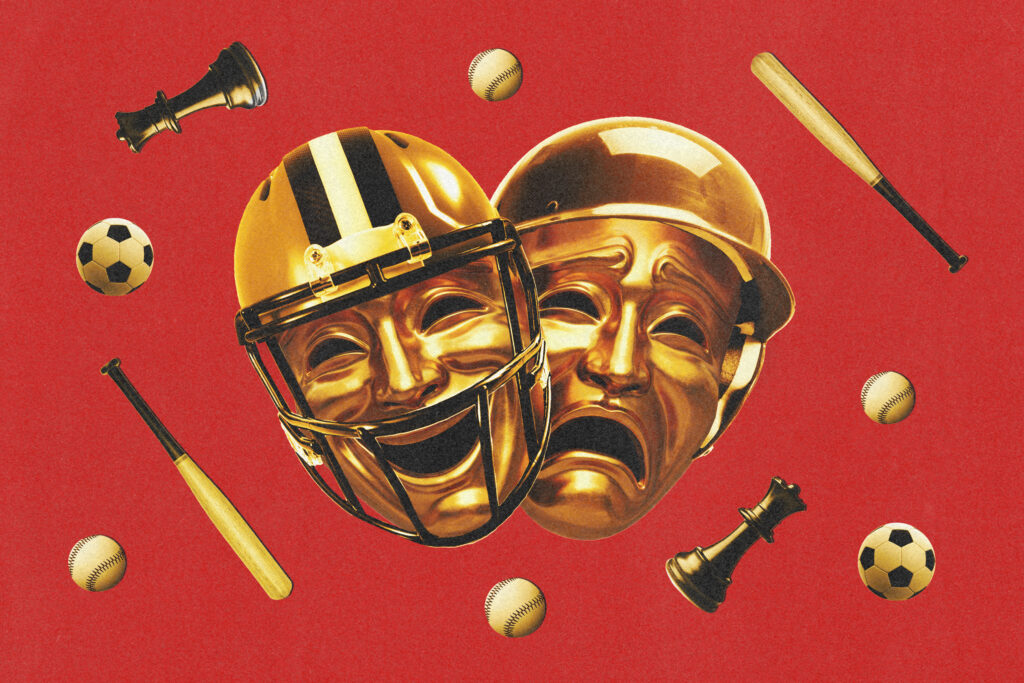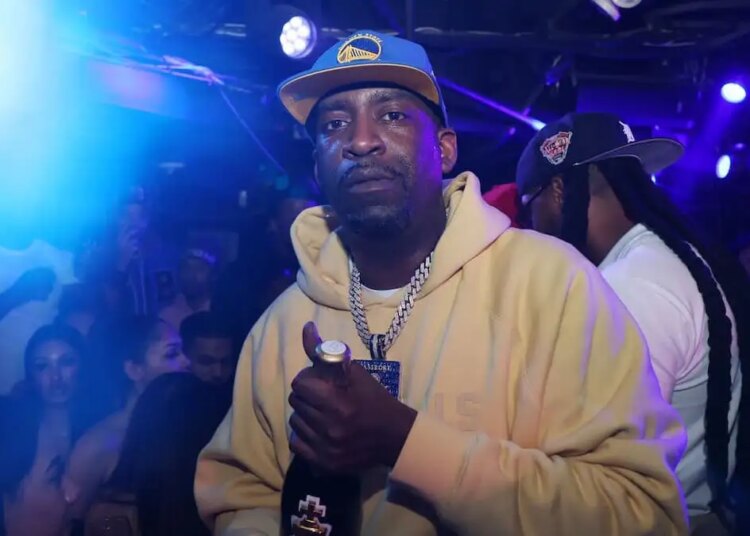As jersey-adorning fans found their seats, vendors hawked hot dogs and the merch stand touted a bucket of baseballs, Paper Mill Playhouse in Milburn, New Jersey, gamely embraced American’s pastime on a recent Sunday afternoon.
The theater’s “Bull Durham” musical — a world-premiere adaptation of the 1988 movie — sufficiently captured baseball’s spirit, even if the show’s script was old-fashioned to a fault. Pitches were hurled, bats were cracked and nerves were rattled. Awe-inspiring athleticism took center stage. Patrons belted “Take Me Out to the Ballgame” after stretching their legs (during intermission, not the seventh inning), and they applauded top-tier performers.
Sports and theater might seem like an odd duo, but they’ve been teaming up frequently this fall. At D.C.’s Arena Stage, an acclaimed revival of the Golden Age standby “Damn Yankees” joined “Bull Durham” in transporting baseball diamonds to the stage. Olney Theatre Center in Maryland hosted the U.S. premiere of “Red Pitch,” a West End play about soccer-playing teens harboring English Premier League dreams. A new version of “Chess,” the 1986 musical centered on Cold War-era grandmasters, is in previews on Broadway. (Before you call foul: Chess is an International Olympic Committee-recognized sport, even if it hasn’t featured at the Games.)
Those productions draw from a deep bench of sports-fueled plays and musicals. Baseball has also tossed us “Take Me Out” and “Toni Stone.” Soccer kicked over “Dear England” and “The Wolves.” Boxing’s onstage heavyweights include “The Great White Hope,” “Fetch Clay, Make Man” and “Rocky the Musical.” And “King James” takes a shot at dramatizing basketball.
Sports and theater, the tired trope tells us, form a Venn diagram with the slimmest of overlaps. After all, what does a jock have in common with an artiste? The beer-chugging fanatics who pack stadiums aren’t the wine-sipping cosmopolitans who frequent the arts, right?
Yet the two have plenty in common. As a sports obsessive and avid theatergoer, I’ve always found the communal experiences staggeringly similar. Either way, we root and cheer and gasp in unison. Worship-worthy idols emerge — and nothing beats seeing them ply their trade in person. Whether I’m gazing at a field or stage, I see narratives and subplots, heroes and villains, twists and turns.
Consider some extremely recent history: The Los Angeles Dodgers’ triumph over the Toronto Blue Jays in Game 7 of the World Series earlier this month was drama of the highest order. The long-suffering Jays continually coming within inches of winning it all, only to fall short and watch the juggernaut Dodgers exult on their infield? Arthur Miller would cringe at such ruthless tragedy. So it’s easy enough to understand why playwrights turn to sports time and time again.
“There’s stakes and competition, and you’re rooting for people to achieve a very specific goal,” said Danny Strong, the Emmy winner who wrote a new book for the Broadway revival of “Chess.” “I think that creates its own set of stakes, which hopefully draws an audience in to how it’s going to turn out.”
It helps that competitors make endlessly compelling characters. Every protagonist navigates wins and losses — sports-centric shows just literalize the concept. With the pursuit of greatness inevitably come fist pumps of triumph and gut punches of defeat. And there’s something tantalizing about introducing an elite talent — like, say, the burned-out champ Freddie Trumper in “Chess” or the otherworldly slugger Joe Hardy in “Damn Yankees” — and studying the perks and perils of achieving such greatness.
“What you sacrifice to be an artist, I felt a real parallel to what chess players sacrifice to be competitive,” Strong said. “But I think that that’s universal, not just from chess players and artists but so many professions where you have a deep passion.”
Sports also reflect broader societal talking points — a reality many a playwright has capitalized on.
Reworking Tim Rice’s original “Chess” concept, Strong wrote a script that amplifies the U.S.-Soviet chess rivalry as a Cold War allegory. “Red Pitch” playwright Tyrell Williams uses an improvised asphalt soccer field as ground zero for a contemporary gentrification parable. “The Great White Hope,” Howard Sackler’s Pulitzer Prize-winning 1967 play, fictionalized Black boxer Jack Johnson’s rise at the height of the Jim Crow era. Richard Greenberg’s 2002 play “Take Me Out” explored homophobia in a baseball clubhouse a decade before NBA player Jason Collins became the first openly gay male athlete in a major American sports league.
The early 1900s-set “Ragtime,” now enjoying a majestic Broadway revival, may not be a sports musical, but the second act number “What a Game” does use a boisterous baseball crowd to signal the dawn of a more unruly age. And there’s a potent moment in the rousing “Liberation,” a new play now on Broadway, about how women used to play half-court basketball because men didn’t think they could run the full distance.
For a prolifically revived show like “Damn Yankees,” different iterations speak to different eras. Bowing on Broadway in 1955, the crowd-pleasing Faustian tale was imbued with mid-century pep. When playwrights Doug Wright and Will Power set out to modernize the musical, they added dramatic weight by making Joe’s father a Negro Leagues standout who never got a shot at the majors. Wary of overburdening a lighthearted romp, however, they also shifted the focus not to today but to 2000 — and a pre-9/11 innocence worthy of the source material’s diverting exuberance.
The show “was created at a time where the world had just gone through World War II and when baseball became a huge sport, and the sport itself was used as a way to uplift communities and it became a huge American tradition,” said Sergio Trujillo, who directed and choreographed the “revisal,” which has Broadway aspirations.” “There’s such as an overabundance of spirit and celebration for me, which really reflect what this country is.”
Then there’s the obvious sandbox for spectacle. In “Bull Durham,” director Marc Bruni used sliding runners, bat flips and bench-clearing brawls to power a song-and-dance extravaganza. Any decent “Damn Yankees” staging mines some fun from asking its macho ballplayers to twirl, shuffle and tap as if they play for the Savannah Bananas.
But as Trujillo emphasized in his kinetic “Damn Yankees” production, which brought on coach Tony Mercado as a baseball consultant, there’s value in balancing authenticity and artistry. That, after all, is where sports shows can make unforced errors. Although audiences understand dramatic license, they’ll see right through the clumsy handling of a game they cherish. Unlike sports movies and series, stage productions can’t lean on stunt doubles or editing tricks to cover for an ungainly actor.
“I wanted to make sure that those boys know when they’re batting, when they’re throwing, when they’re catching, that we’re not just faking,” Trujillo said. “So I always took that very much into consideration, because I think authenticity really pays off.”
It helps that the grace and athletic prowess needed to excel in sports can translate onstage. (The 2000 musical “The Full Monty” riffed on this idea with the number “Michael Jordan’s Ball,” in which burly dancing neophytes learn how to bust a move through sports analogies.) This past summer, when I attended a “Red Pitch” training session in which actors played soccer alongside talented Howard County teenagers, there was no mistaking the show’s stars for World Cup prospects. But by the time “Red Pitch” premiered in September, the central trio — Terrence Griffin, Angelo Harrington II and Ty’Ree Hope Davis — had developed enough on-the-ball ease to sell the play’s soccer sequences with aplomb.
“It’s all choreography,” Davis said. “It just goes with your natural movement, and you find the freedom in it.”
That said, the best sports set pieces are less focused on verisimilitude than character insight. There’s a critical moment in “Red Pitch” when one player’s deep-seated resentments manifest in a crunching tackle. In “Bull Durham,” Nuke LaLoosh’s lack of control on the mound stands in for the flamethrowing pitcher’s erratic love life. Strong’s version of “Chess” uses the matches as an opportunity for the players to spill their inner monologues between calling out their moves.
Ultimately, the pressure cooker of competition serves up camaraderie, conflict, heartbreak and revelry. There’s a reason that Old Trafford, Manchester United’s cathedral of a soccer stadium, is nicknamed the Theatre of Dreams. And several current or former United players — Marcus Rashford, Jadon Sancho and Harry Maguire — are even characters in “Dear England,” James Graham’s Olivier Award-winning play about the England men’s soccer team’s eschewing of hypermasculinity and embrace of sports psychology.
Sports can be theater, and theater can be sports. Either way, the crowd wins.
The post Theater about sports sounds like it won’t work. But it can be exhilarating.
appeared first on Washington Post.




